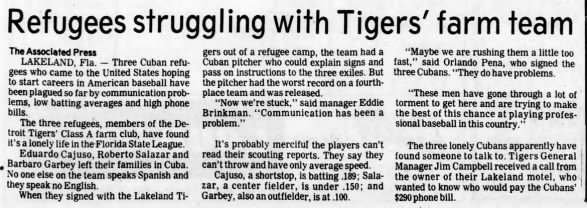My route to covering the Detroit Tigers was an unusual one. I have been called crazy for writing for free, for years. But you take reps, learn from others, and apply into a passion that I am fortunate and grateful for being able to do this. It has been an unconventional journey here, similar to a former Tiger by the name of Barbaro Garbey.
Last season, the Detroit Tigers honored Barbaro Garbey for his role on the 1984 World Series team during ¡Fiesta Tigres! He was 27 years old when he made his major league debut on April 3rd, 1984. At that point, he was the first Cuban-born and-trained player to make his debut in the majors since Tony Perez in 1964. Garbey was also the first Cuban to play in the Serie Nacional, defect and play in the majors. He got to the United States via the “freedom flotilla” aka the Mariel boat lift in 1980.
After Commissioner Bowie Kuhn disbanded the embargo on signing Cuban refugees, former Tigers pitcher now turned scout Orlando Peña (1965-1967) signed Garbey as well as Eduardo Cajuso and Roberto Salazar. Peña discovered Garbey while he was playing pepper in jeans and a t-shirt.
But life early on at Single-A Lakeland was tough for all three players. Even the press, early on, did not exactly paint a picture of “warmth” after just a few weeks in minor league ball.
“When I start playing in Lakeland, we only have one coach. One coach that was the manager that was the was in charge of everything,” Garbey said. “In other words, we were making an adjustment ourselves. We didn’t have a hitting coach, we didn’t have a pitching coach. We had to learn on our own. We didn’t have the instructions or facilities they have now.”
Fallen behind the times
Garbey has been watching this year’s Caribbean Series. Cuba, which was dominant on the world stage for so long, is now more of an afterthought. They are 1-6 in the series so far.
“Baseball has evolved, and Cuba did not evolve with the game,” Garbey said. “They’re stuck in the same game, the same preparation, the same coaching, the same way of playing the game. The preparation is different for the other teams, who have evolved, and now they are playing much better quality opposition.”
With the current crop of Cuban players across the league (Roberto Campos, Lazaro Benitez down with the Lakeland Tigers) Garbey mentioned a key difference from when he first arrived to the players now.
“But now because they are not weight lifting or anything like that, Cuba, we were not weight lifting either,” he said. “Now you see the player who came from Cuba lately, they get with the program here in United States, and you see they come here weighing like 170 pounds and two months later, you see them 200, 250 pounds because of the training here in the United States. So when they come here to the States, the teams have the facilities.”
Garbey stressed it is the same process for all Latin ballplayers who come to the United States. He has seen the evolution first hand as he has been coaching in the minors for over 20 years. Most recently, he was a manager with the Bristol State Liners, who are part of the Appalachian League, a collegiate development league.
Ironically enough, Bristol was the home of the Tigers rookie A team from 1969 to 1994. He has coached players like Ronald Acuna Jr., Austin Riley and Dansby Swanson while spending most of his coaching days as a hitting coach.
“I cannot teach the players right now the way I was playing or the way I was hitting because the game is different,” Garbey said. “So I have to evolve, and that’s, that’s a mistake a lot of coaches make. They want to coach, they want to teach the kids the way they were playing it. That’s not the way it is. You know, teach the kids, based on their talent the way the game has been playing right now, to analyze in how they can get better as competition gets tougher.”
Garbey has taken a long journey to get where he is today. The road has not been the typical one to start. But for a player who saw five seasons in the majors, he continues his journey by helping minor league players have a better road to the show.

